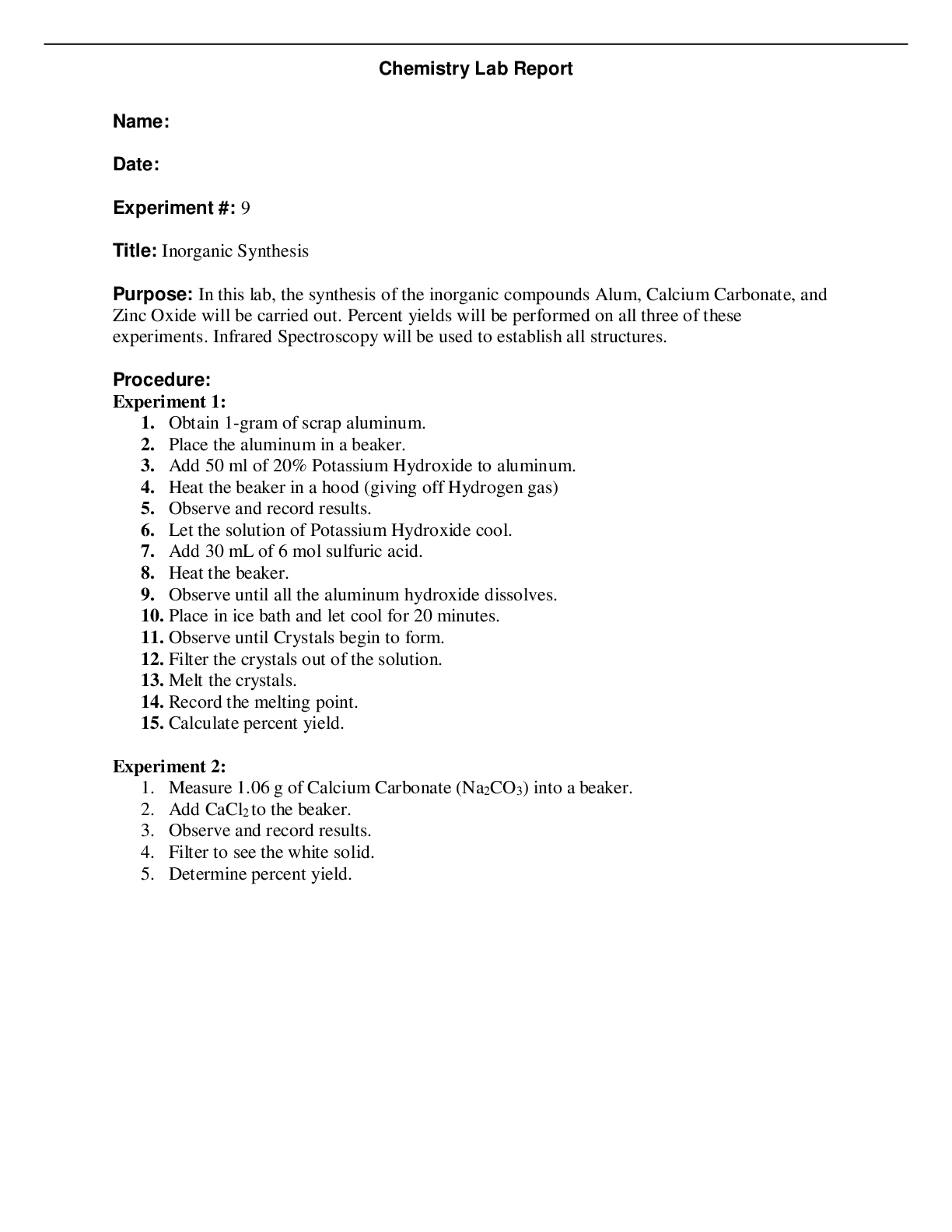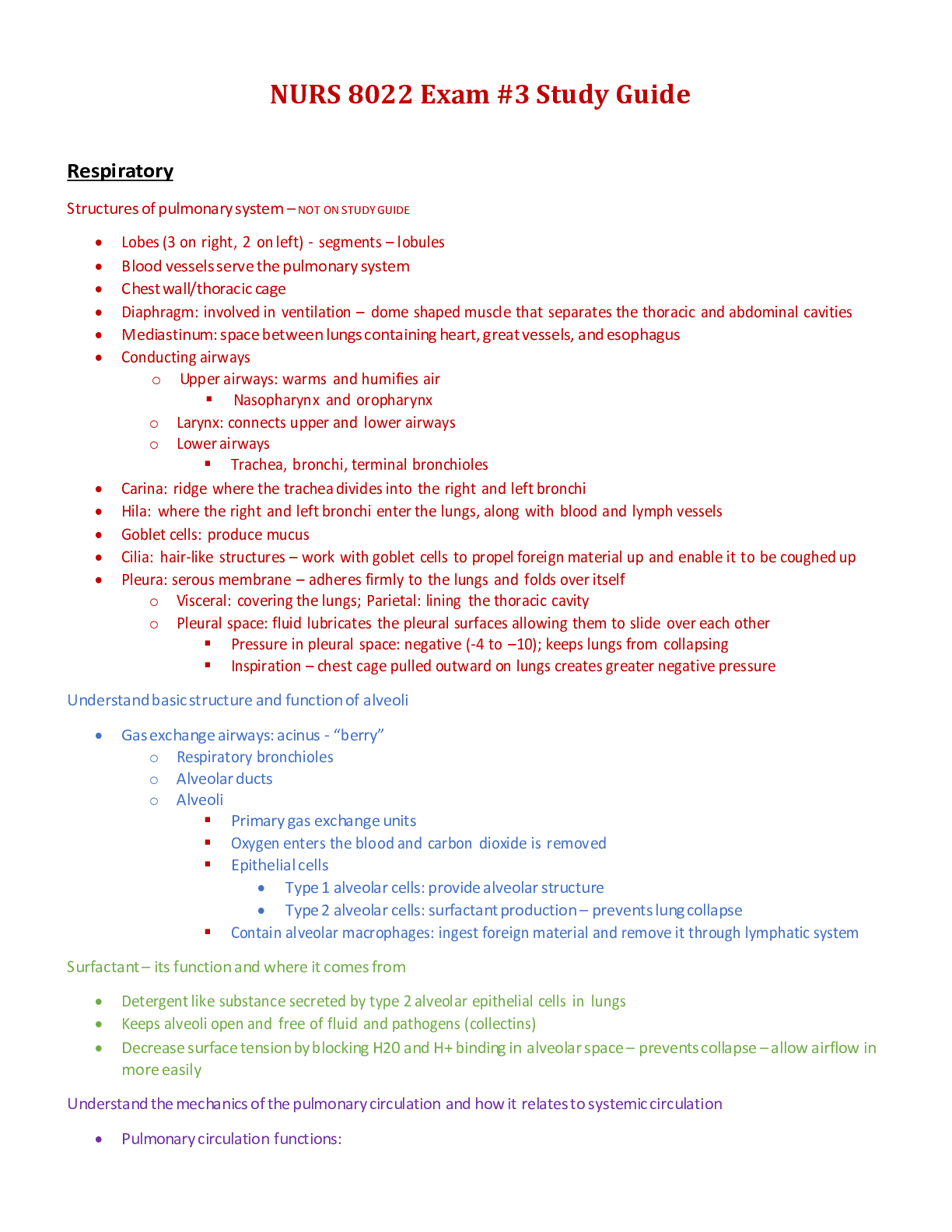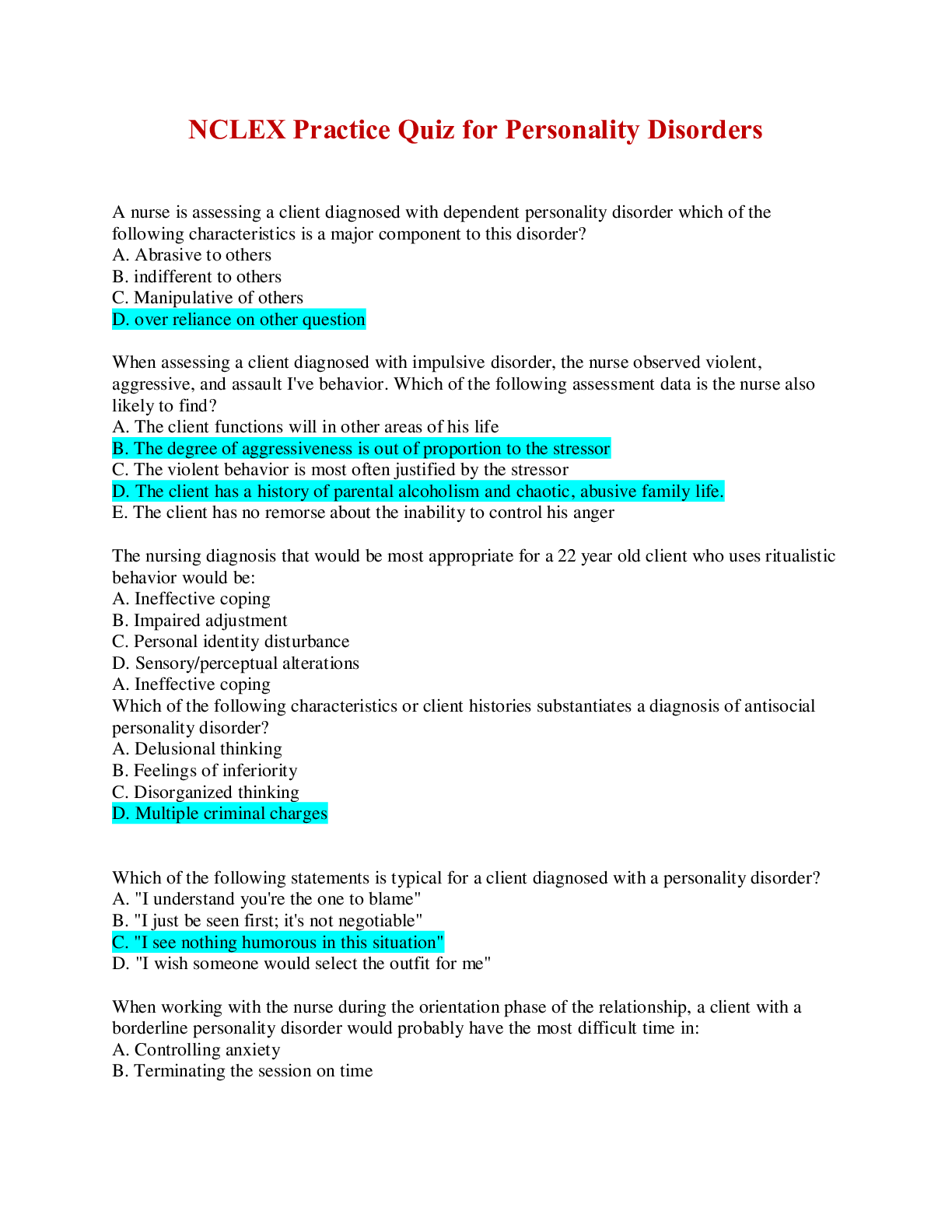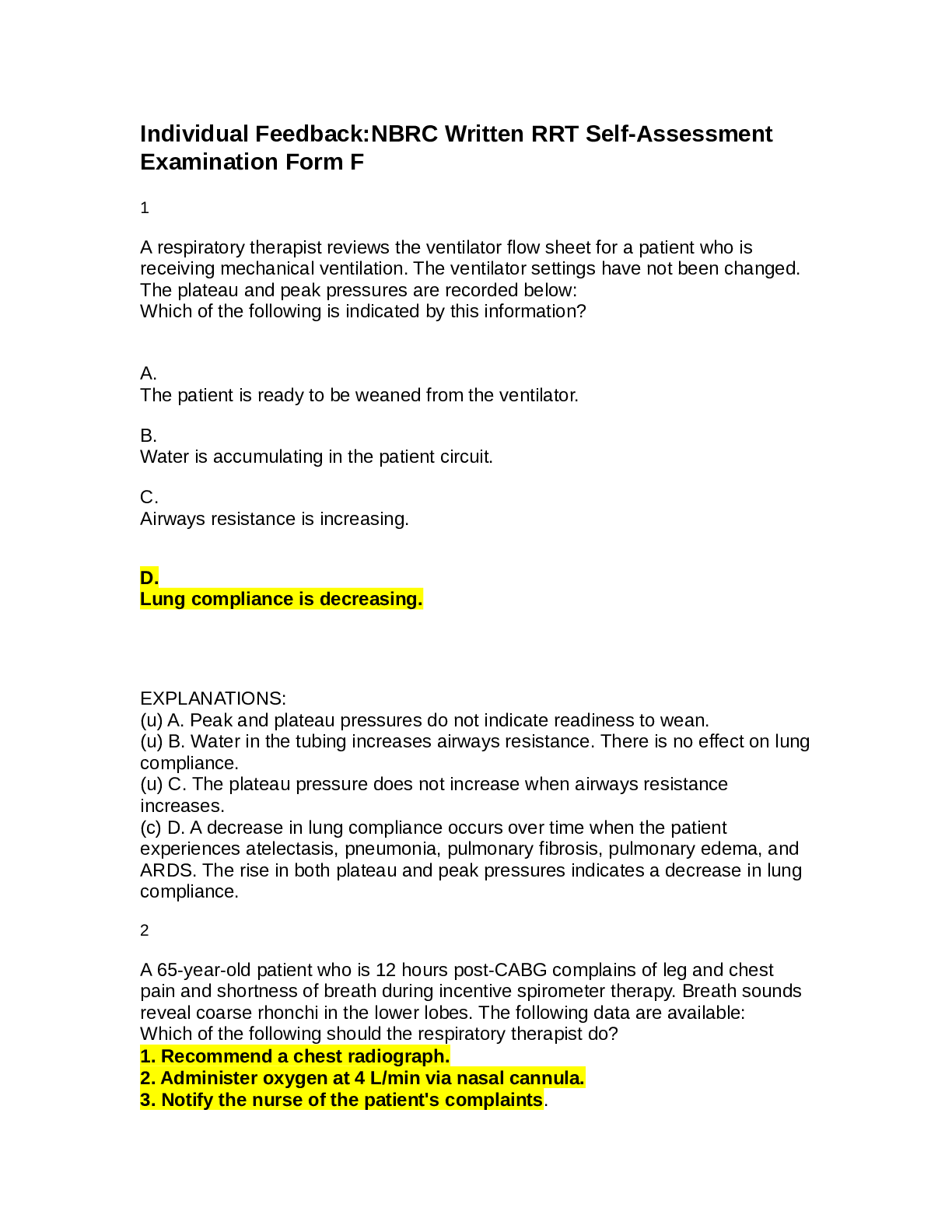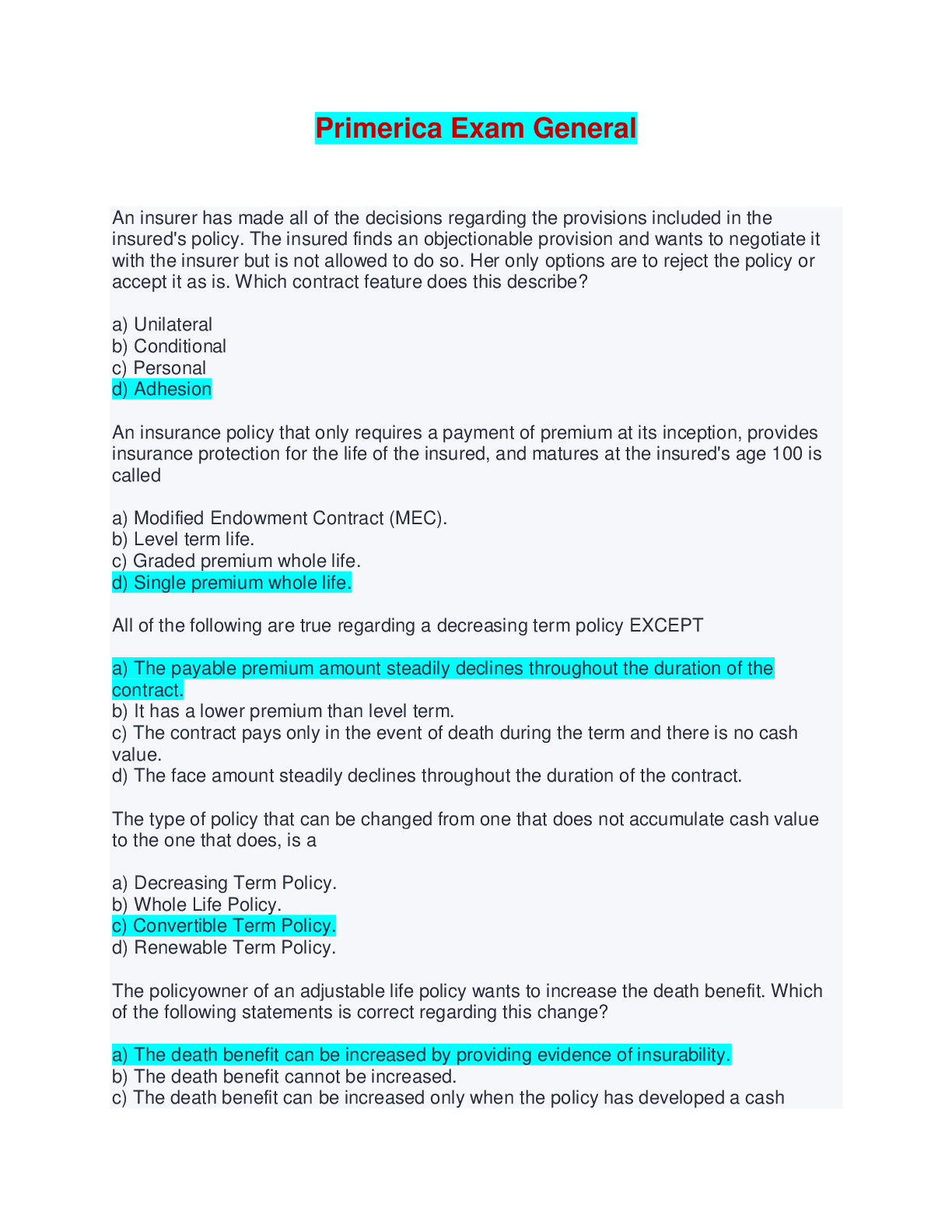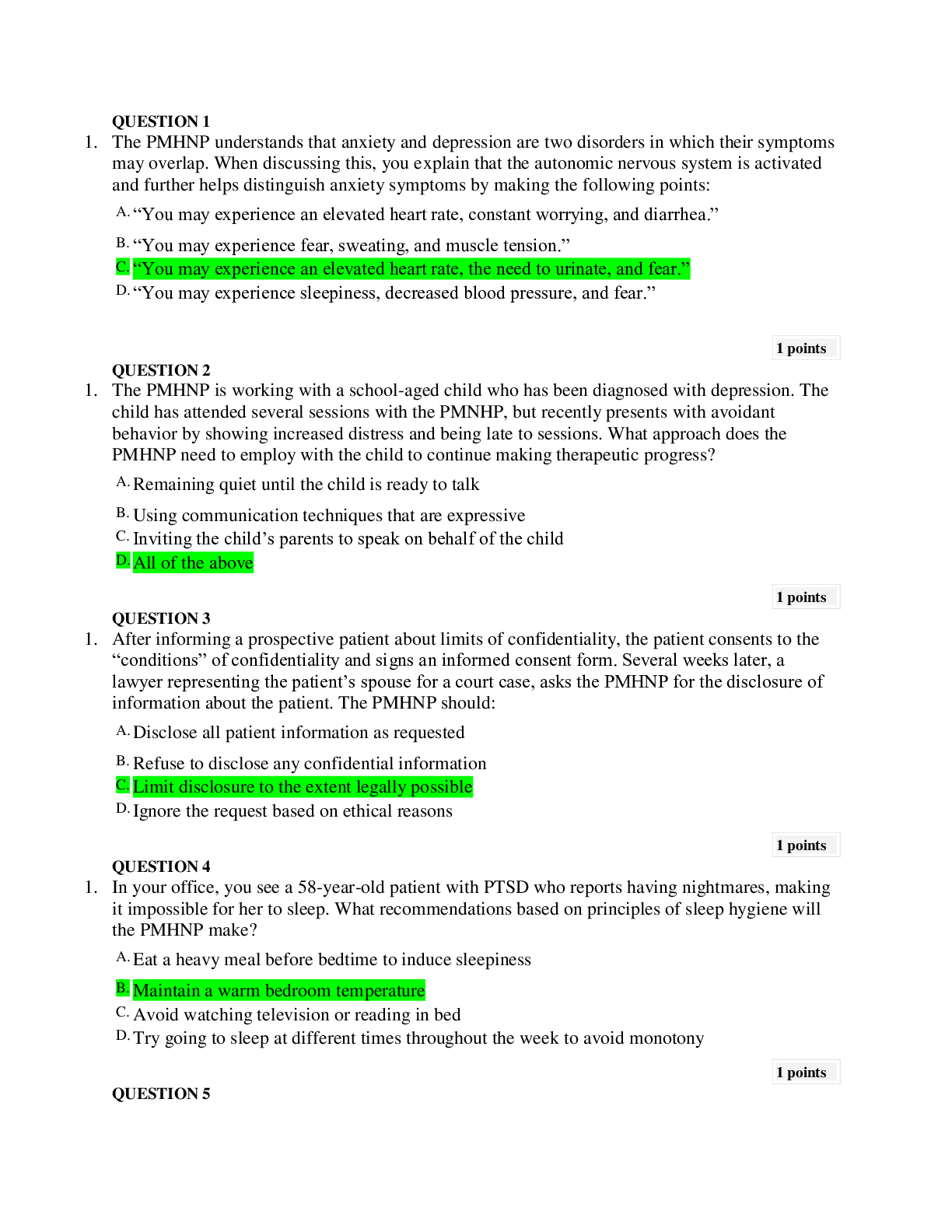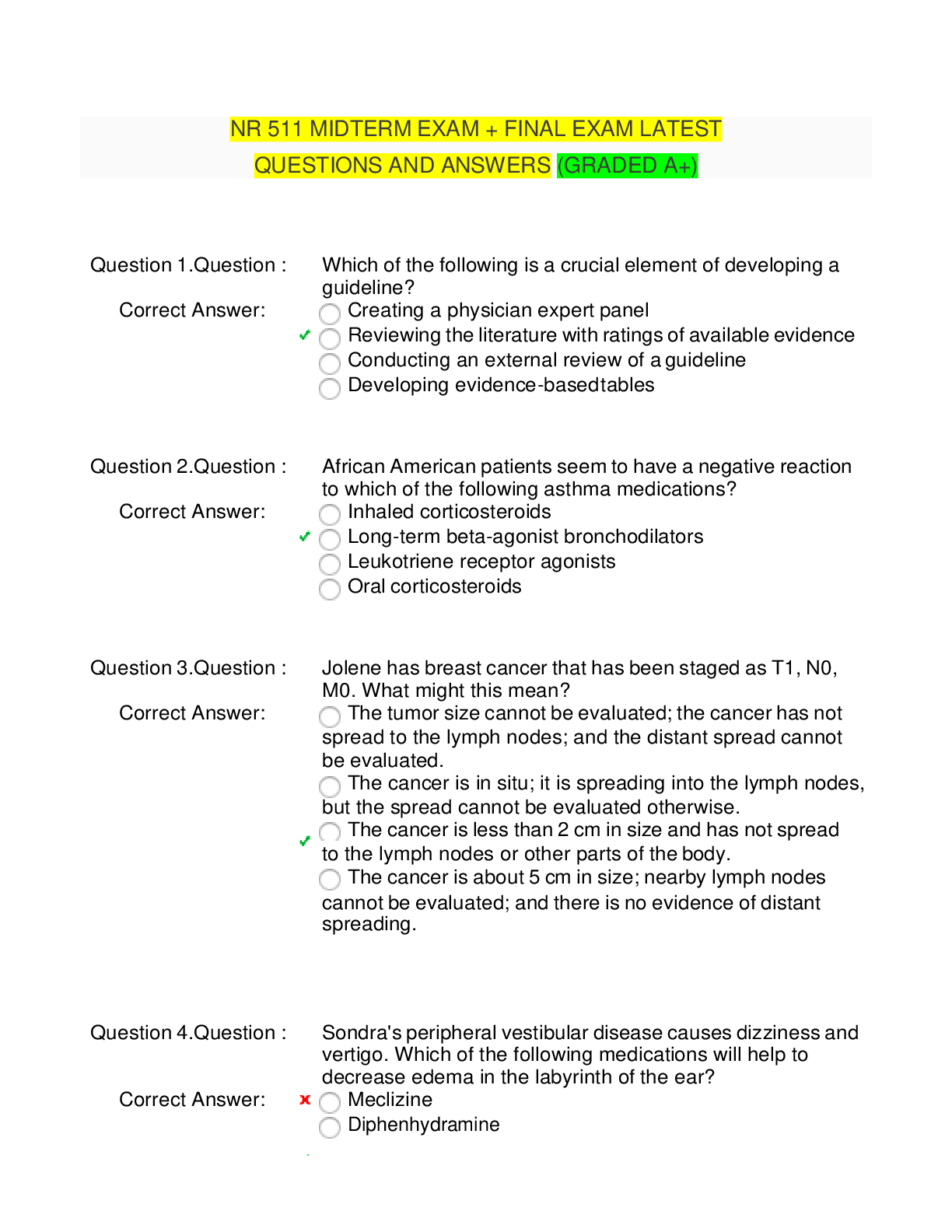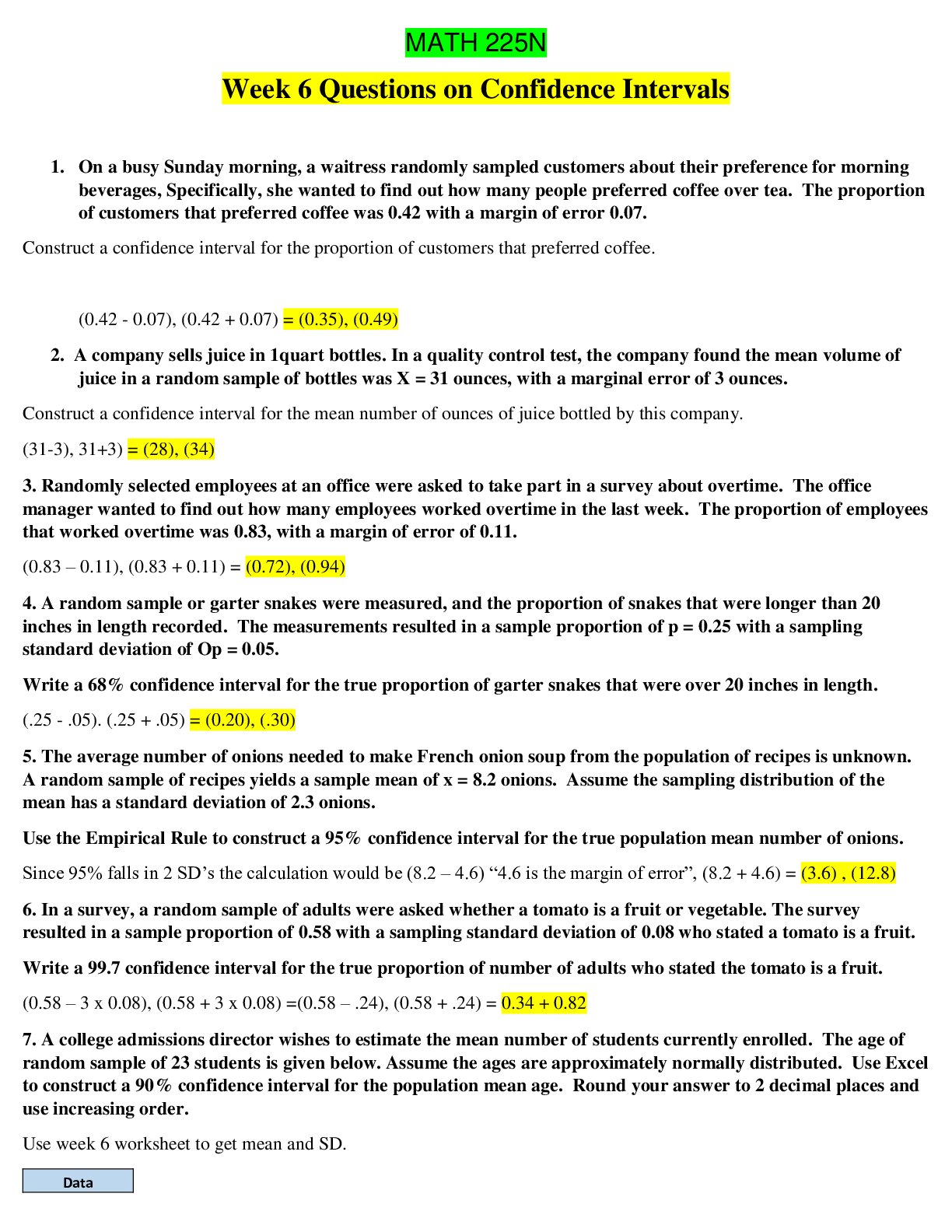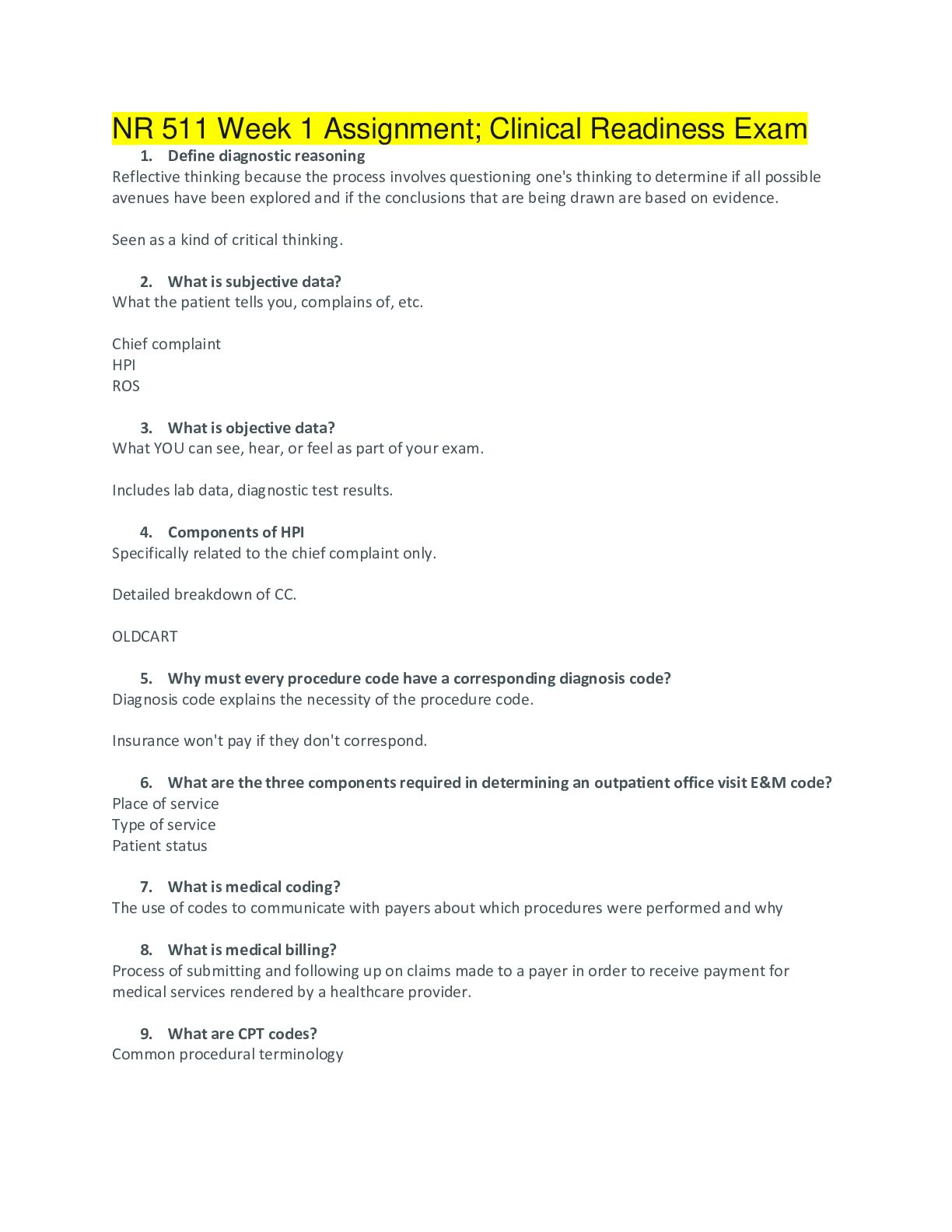M2 FINAL COACHING EXAM - Questions and Answers (Complete Solutions)
Document Content and Description Below
M2 FINAL COACHING EXAM - Questions and Answers (Complete Solutions) Select the site of pyruvate formation during glycolysis A. Liver B. Muscles C. Heart D. Lungs Choose the organelle, found close to... the endoplasmic reticulum, which receives and acts on proteins and membrane lipids to further modify them and then passes these on to other parts of the cell through budding vesicles A. Golgi apparatus B. Lysosomes C. Ribosomes D. Mitochondria Select the organelles that have digestive vesicles and contain enzymes that degrade proteins and nucleic acids A. Ribosomes B. Mitochondria C. Golgi apparatus D. Lysosomes Classify the amino acids according to their side-chain functional groups: Glutamate, aspartic acid A. Sulfur-containing side chain B. Aromatic side chain C. Carboxylic acids D. Basic side chain Identify the chemical bond that joins amino acids together in a protein molecule A. Peptide B. H-bonds C. lonic bonds D. Dipole-dipole Identify the characteristic functional groups of amino acids A. Amino acid and carboxylic acid groups B. Amino and hydroxyl groups C. Hydroxyl and carboxylic acid groups D. Methyl and carboxylic acid groups Identify the simplest amino acid among the 20 common amino acids A. Serine B. Alanine C. Glycine D. Lysine Identify the nucleotide which is responsible for reading the complementary DNA message A. rRNA B. tRNA C. hnRNA D. mRNA Find the examples of transport and storage proteins A. Ribonuclease, hexokinase B. Actin, myosin C. Hemoglobin, myoglobin, serum albumin D. Keratin, actin Identify the stage in protein synthesis when the anticodon of tRNA recognizes the codon on Mrna A. Termination B. Transcription C. Translation D. Elongation Identify the site of the initial stage of protein synthesis A. Cytoplasm B. Golgi apparatus C. Ribosomes D. Nucleus Analyze and select the underlying principle in the ninhydrin test for proteins A. Based on the reaction of cupric ions of the reagent with the N of the peptide bonds forming a purple or violet-colored complex B. Based on the nitration of proteins, which leads to the formation of a yellow precipitate that turns into orange on treatment with an alkali C. Based on the reaction between the phenolic group of a protein with mercuric sulfate in the presence of sodium nitrite and sulfuric acid resulting in the formation of a red-colored solution D. Based on the reaction between the reagent and the amino group of the free amino acid of the test sample, which leads to the oxidation of the compound and its deamination and resulting in the formation of a deep blue colored solution Select the enzyme that hydrolyzes bacterial cell wall A. Carbonic anhydrase B. Lysozyme C. Lactate dehydrogenase D. Kinase Analyze the mechanism or catalytic strategy employed by restriction endonucleases A. Utilization of the free energy associated with the hydrolysis of ATP B. Achievement of a high absolute rate of reaction that is suitable for integration with other physiological processes C. Attainment of a high degree of specificity D. Promotion of a reaction that is immeasurably slow at neutral pH Analyze which enzyme in the Tricarboxylic Acid Cycle catalyzes the condensation of oxaloacetate and acetyl-CoA A. Citrate synthase B. Pyruvate carboxylase C. Aconitase D. Pyruvate dehydrogenase Classify fumarase A. Hydrolase B. Ligase C. Transferase D. Lyase Analyze the mechanism or catalytic strategy employed by carbonic anhydrase A. Utilization of the free energy associated with the hydrolysis of ATP B. Achievement of a high absolute rate of reaction that is suitable for integration with other physiological processes C. Attainment of a high degree of specificity D. Promotion of a reaction that is immeasurably slow at neutral pH Analyze which enzyme in the Tricarboxylic Acid Cycle catalyzes the carboxylation of pyruvate to give oxaloacetate A. Citrate synthase B. Pyruvate carboxylase C. Fumarase D. Pyruvate Identify the zymogen that is activated by the enzyme trypsin A. Fibrinogen B. Pepsinogen C. Trypsinogen D. Procarboxypeptidase Classify nucleoside monophosphate kinase A. Ligase B. Hydrolase C. Lyase D. Transferase Identify the carbonic anhydrase inhibitor that finds clinical application in the treatment of glaucoma by reducing intraocular pressure A. Celecoxib B. Sulfanilamide C. Acetazolamide D. Pirenoxine Find the complementary base pairs in DNA molecules A. Adenine-Thymine, Cytosine-Guanine B. Adenine-Thymine, Cytosine-Uracil C. Uracil-Thymine, Cytosine-Guanine D. Uracil-Thymine, Adenine Guanine Select the complementary sequence for the DNA segment: GATCAA A. CTGCUU B. CUAGUU C. CTAGTT D. TTAGTT Determine the pathological condition that is caused by the absence of adenosine deaminase, an enzyme in the purine degradation pathway A. Severe combined immunodeficiency B. Neural tube defects C. Gouts D. Lesch-Nyhan syndrome Identify the step in DNA synthesis when DNA polymerase plays a role A. termination B. Primer binding C. Replication fork formation D. Elongation Select the sequence of the mRNA segment synthesized from this DNA template strand: CACCGCCCGTCG A. GUGGCGGGCAGC B. GUGGGGGCCAGC C. GUCGCGGGCAGC D. GUGCCGGGCAGC Determine the pathological condition that is caused by a deficiency in folate derivatives during early pregnancy because of the important role of these derivatives in the synthesis of DNA A. Lesch- Nyhan syndrome B. Severe combined immunodeficiency C. Gout D. Neural tube defects Pick the odd one out A. Telomeres B. Okazaki fragments C. Leading strand D. Lagging strand Select the category to which D-glucose and Dmannose belong A. Enantiomers B. Epimers C. Aldose-ketose D. Diastereomers Select the carbohydrate that is administered as an intra-articular injection in cases of osteoarthritis A. Keratin sulfate B. Hyaluronic acid C. Heparin D. Beta-D-hexosaminidase-A Classify the carbohydrates starch, cellulose, and inulin A. Heteroglycans B. Homoglycans C. Trisaccharides D. Disaccharides Find the statement that is NOT correct about glycolysis A. The first part of glycolysis works on the six-carbon molecule, preparing it for oxidation B. The third part operates on one of the glyceraldehyde-3 phosphate molecules, oxidizing it to yield energy C. One glucose molecule generates two molecules of pyruvate and two units of ATP D. The second part of glycolysis splits the sixcarbon molecule into three two-carbon fragments Identify the type of chemical reaction in the conversion of glyceraldehyde-3-phosphate to 1,3bisphosphoglycerate A. Phosphoryl shift B. Aldol cleavage C. Isomerization D. Reduction-oxidation Identify the type of chemical reaction in the conversion of fructose 1,6-bisphosphate to glyceraldehyde-3-P and dihydroxyacetone phosphate A. Aldol cleavage B. Phosphoryl shift C. Isomerization D. Reduction-oxidation Identify the end product of glycolysis A. Phosphoenolpyruvate B. Pyruvate C. Fructose-6-phosphate D. Glyceraldehyde-3-phosphate Select the carbohydrate used as an acidulant, especially in infant feeding formulas A. High-fructose sweeteners B. Xylose C. Lactic acid D. Mannitol Identify the carbohydrate that is used as a selfbinding diluent and disintegrating agent A. Xylose B. High-fructose sweeteners C. Powdered cellulose D. Lactic acid It measures the degree of unsaturation of the oil. Those which are partially resinify on exposure to air have high values. A. Ester value B. Acetyl value C. lodine value D. Acid value E. Saponification value Refers to the number of mg of potassium hydroxide required to neutralize the acid combined by acylation of the sample. A. Acetyl value B. Peroxide value C. Ester value D. Hydroxyl value E. lodine value Select the class to which prostaglandins belong A. Sphingolipid B. Fatty acid C. Glyceryl ester D. Terpene Select the major storage form of fatty acids A. Ester of a long chain alcohol B. Ester of a monohydric alcohol C. Triglyceride D. Ester of a polyhydric alcohol Identify the essential fatty acids for humans A. Linolenic acid and linoleic acid B. Linoleic acid and alpha-linolenic acid C. Oleic acid, linolenic acid D. Stearic acid, linoleic acid Identify the fatty acid referred to as "omega-3" A. Alpha-linoleic acid B. Beta-linolenic acid C. Oleic acid D. Alpha-linolenic acid This is used for the symptomatic treatment of benign prostatic hyperplasia A. Safflower oil B. Sunflower oil C. Saw Palmetto oil D. Persic oil Starflower oil A. Helianthus anuus B. Carthamus tinctorius C. Borago officinalis D. Serenoa repens The only liquid wax A. Sus scrofa B. Gaddus morrhua C. Physeter macrocephalus D. Simmondsia chinensis Contains a toxic principle that causes male sterility A. Palm kernel oil B. Germ oil C. Rapeseed oil D. Cottonseed oil Drying oil A. Linum ussitassimum B. Gossypium hirsutum C. Sesamum indicum D. Olea europaea Solvents for IM injections, EXCEPT: A. Corn oil B. Cottonseed oil C. Peanut oil D. Soybean oil Used to test Olive oil for Tea tree oil or Camellia oil contamination A. Halphen B. Baudouin C. Millon D. Serger Source of lecithin and stigmasterol A. Peanut oil B. Soybean oil C. Sesame oil D. Corn oil Identify the carrier molecule that transports fatty acids across the inner mitochondrial membrane A. Carnitine B. Chilomicron C. Aldimine D. GLUT Find the statement that is correct about lipids A. Thromboxanes prevent clotting B. Prostaglandins stimulate gastric acid secretion C. Eicosanoids act as messengers inside cells and between neighboring cells D. Linoleoyl-CoA is derived from arachidonyl-CoA Select the statement that BEST describes fatty acid metabolism A. Fatty acid metabolism is NOT tied to carbohydrate metabolism B. Fatty acids and their CoA esters are able to freely cross the inner mitochondrial membrane C. The release of fatty acids and their subsequent Beta-oxidation is a primary source of metabolic energy for the cell D. Fatty acid catabolism is NOT under hormonal control Analyze the mechanism involved in the regulation of DNA replication and synthesis of mRNA A. Compartmentalization B. Enzyme activation C. Hormonal control D. Concentration Select the coenzyme that is required by aminotransferases A. Nicotinamide adenine dinucleotide B. Pyridoxal phosphate C. Flavin adenine dinucleotide D. Nicotinamide adenine dinucleotide phosphate Identify the precursors of gluconeogenesis A. Glycerol, lactic acid, pyruvic acid B. Glycerol, lactate, pyruvate, glucogenic amino acids C. Pyruvic acid, lactic acid, acetic acid D. Sucrose, lactic acid, pyruvate acid Analyze the mechanism involved in the regulation of phosphorylation and glycosylation A. Enzyme activation B. Hormonal control C. Concentration D. Compartmentalization Enzyme L A. Arginase B. Argininosuccinase C. Argininosuccinic synthetase or Lyase D. Carbamoyl phosphate synthetase Ornithine transcarbamoylase [Show More]
Last updated: 1 week ago
Preview 5 out of 34 pages
Instant download

Loading document previews ...
Buy this document to get the full access instantly
Instant Download Access after purchase
Add to cartInstant download
Also available in bundle (1)
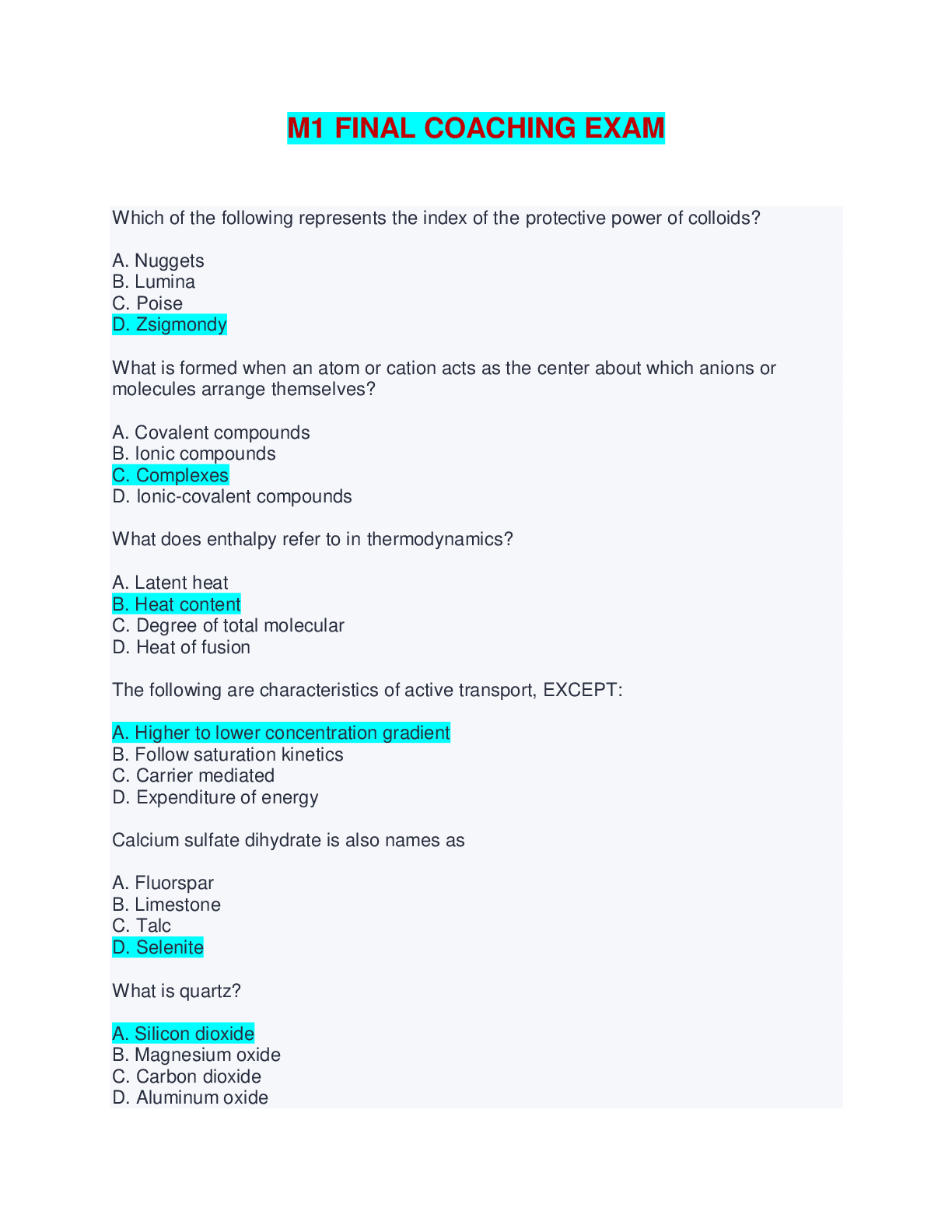
M1 - M6 FINAL COACHING EXAMS BUNDLE
M1 - M6 FINAL COACHING EXAMS BUNDLE
By Nurse Henny 1 week ago
$50
6
Reviews( 0 )
Document information
Connected school, study & course
About the document
Uploaded On
Jun 12, 2024
Number of pages
34
Written in
Additional information
This document has been written for:
Uploaded
Jun 12, 2024
Downloads
0
Views
8



